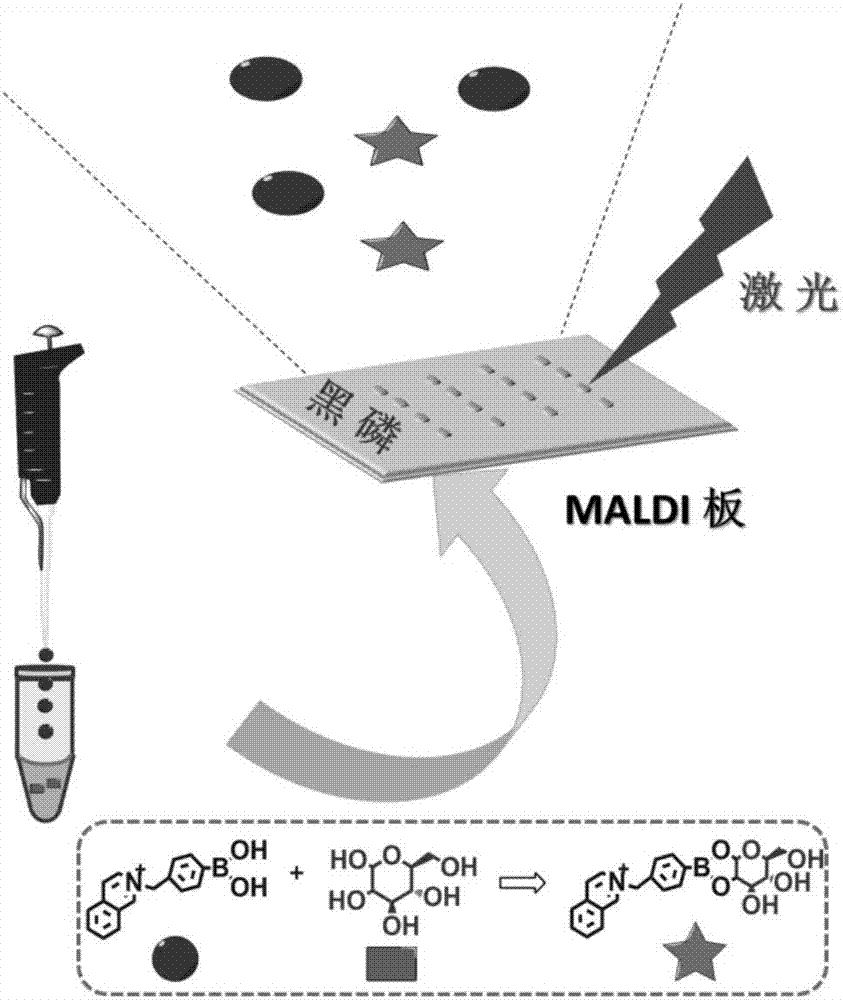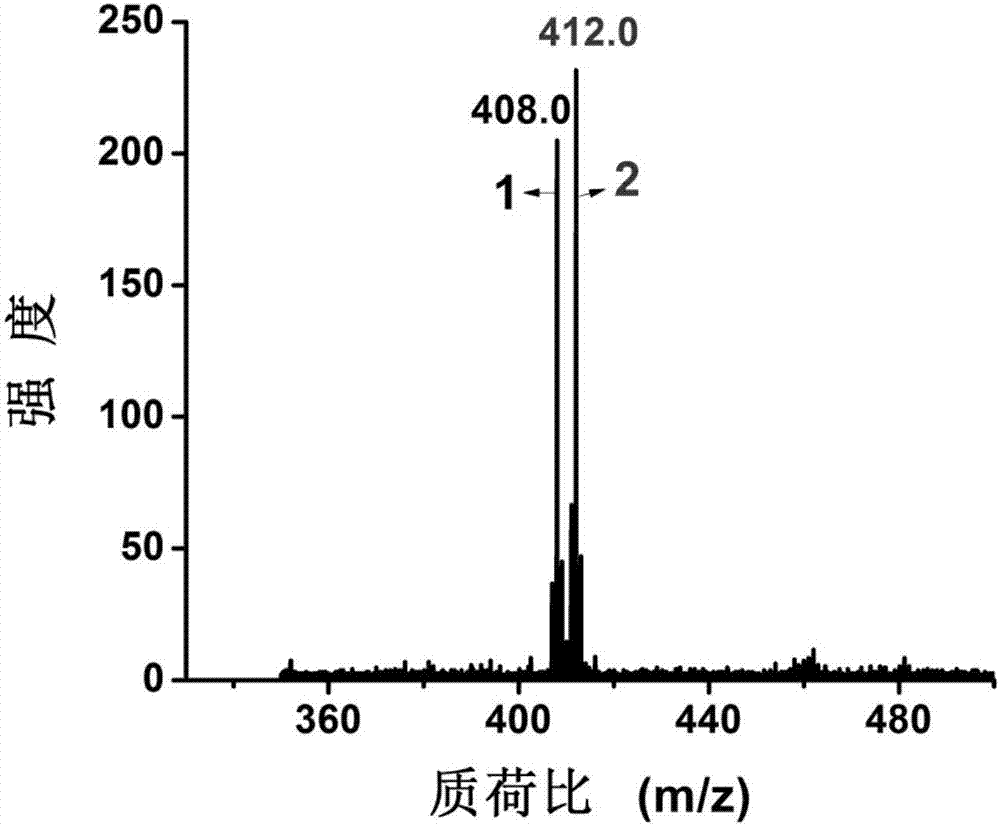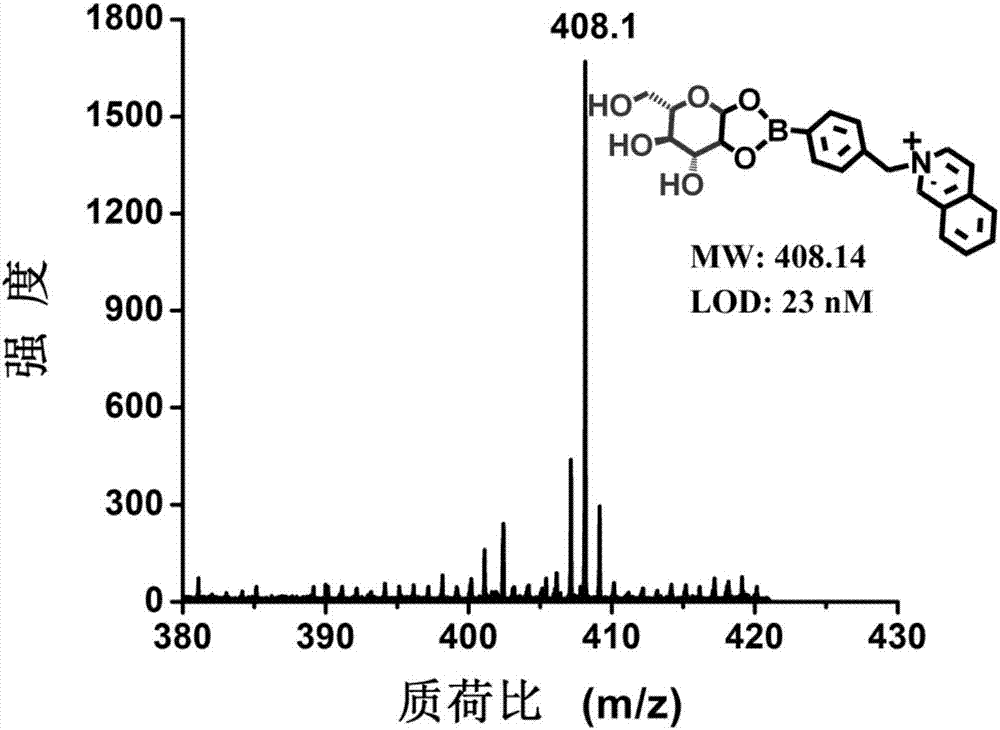Method for rapidly, sensitively and quantitatively detecting glucose in serum
A technology for quantitative detection of glucose, applied in the field of quantitative detection of glucose in serum, can solve the problems of difficult quantitative detection of glucose, inability to achieve high throughput, matrix signal interference, etc., to enhance selectivity and sensitivity, solve poor reproducibility, Effect of Rapid Quantitative Analysis
- Summary
- Abstract
- Description
- Claims
- Application Information
AI Technical Summary
Problems solved by technology
Method used
Image
Examples
Embodiment 1
[0024] The features and advantages of the present invention can be further understood through the following detailed description in conjunction with the accompanying drawings. The examples provided are only illustrative of the method of the present invention and do not limit the rest of the present disclosure in any way. [Example 1] 2-(4-phenylboronic acid) isoquinolinium bromide labeling combined with black phosphorus assisted laser desorption ionization-time-of-flight mass spectrometry for the detection of glucose in serum
[0025] Preparation of standard curve: Prepare solutions containing glucose standards, the concentrations of which are 0.02, 0.2, 2, 5, 10, 20, 50mmol / L, in which the isotope internal standard [ 2 h 4 ] Glucose was fixed at 5.56mmol / L, and the samples of each concentration were done in parallel three times. After chemically labeling with 10mg / mL 2-(4-phenylboronic acid) isoquinolinium bromide, the samples were classified according to the concentration fr...
Embodiment 2
[0033] [Example 2] 1-(4-phenylboronic acid)pyridinium bromide labeling combined with black phosphorus assisted laser desorption ionization-time-of-flight mass spectrometry for the detection of glucose in serum
[0034] Accurately measure 0.5 μl of serum and place it in a 200 μl centrifuge tube, add 0.5 μl, 2 mg / ml isotope internal standard [ 2 h 4 ] Glucose, ultrasound for 30 seconds. Add 1.5 microliters of acetonitrile, vortex for 30 seconds and centrifuge at 12,000 rpm for 1 minute. Transfer the supernatant to a new 200 μl centrifuge tube, add 0.5 μl, 10 mg / mL 1-(4-phenylboronic acid) pyridinium bromide, and react in a 700W microwave oven on high for 3 minutes. 0.4 μl of the reacted solution was taken for black phosphorus-assisted laser desorption ionization-time-of-flight mass spectrometry analysis. Such as Figure 4 As shown, 3 is the 1-(4-phenylboronic acid) pyridine-labeled product of endogenous glucose detected in serum. For the qualitative determination of glucose...
Embodiment 3
[0036] [Example 3] The method of the present invention is used for the detection of glucose in the serum of clinical samples
[0037] We obtain 54 serum samples clinically, have measured the glucose content in every serum sample with the method of clinical hexokinase; We apply the method of the present invention to measure its glucose content again, and two The results were analyzed by linear regression. Such as Image 6 As shown, although there are differences between the two results, there is a strong correlation, and the linear regression coefficient is 0.9754, indicating that the present invention can be applied clinically to carry out accurate, high-throughput and highly sensitive quantification of glucose in serum detection.
PUM
 Login to View More
Login to View More Abstract
Description
Claims
Application Information
 Login to View More
Login to View More - R&D Engineer
- R&D Manager
- IP Professional
- Industry Leading Data Capabilities
- Powerful AI technology
- Patent DNA Extraction
Browse by: Latest US Patents, China's latest patents, Technical Efficacy Thesaurus, Application Domain, Technology Topic, Popular Technical Reports.
© 2024 PatSnap. All rights reserved.Legal|Privacy policy|Modern Slavery Act Transparency Statement|Sitemap|About US| Contact US: help@patsnap.com










